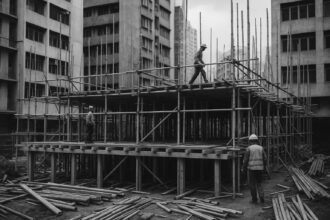New planning applications for nearly 70,000 homes in England rose significantly in Q2 2025, reversing a multi-year decline and reflecting developer confidence driven by recent government reforms. However, prolonged planning approval delays and a decade-low permission rate threaten the government’s 1.5 million homes target.
New planning applications for nearly 70,000 homes were submitted across England in the second quarter of 2025, marking a significant 33% increase compared to the same period in 2024. According to TerraQuest, whose platform processes about 95% of planning applications in England, 232,692 planning applications were lodged from April to June, with proposals for 69,597 new homes—a reversal of a three-year downward trend in planning activity. This surge brings the total number of homes proposed in the first half of 2025 to around 141,000, up from 101,000 in the first six months of 2024, though it remains slightly below the 149,000 proposed by mid-2023.
TerraQuest’s chief executive Geoffrey Keal attributes this rise to increasing confidence within the development sector, likely influenced by favourable government policy signals such as the updated National Planning Policy Framework (NPPF) and the ongoing Planning and Infrastructure Bill currently under consideration in the House of Lords. Keal noted that planning application figures serve as an early market sentiment indicator since they represent the earliest stage in the development process, often months ahead of actual construction activity. Despite this optimism, the figures are yet to fully align with the government’s ambitious target of delivering 1.5 million new homes, but they signal a foundation being laid for greater future activity as planning reforms continue to be implemented.
Regionally, the increase in home proposals was evident across seven of England’s eight regions, with the East Midlands and West Midlands experiencing the sharpest rises of 83% and 72% respectively. These areas have also seen growth compared to the same quarter in 2023, alongside gains in the North East, while the North West lagged behind the rest of the country. Mary-Jane O’Neill, head of planning at Lambert Smith Hampton’s London and South region, highlighted that the December 2024 updates to the NPPF have encouraged more speculative and strategic planning submissions, especially in areas with local plans under review or withdrawn. She pointed to a softer housing delivery test and reinforced support for brownfield development as factors reducing risk for developers and stimulating pre-application engagement and design-led discussions—signs of underlying market confidence.
While planning applications and intentions are rising, the challenge remains in translating these proposals into actual homes. Industry data reveals significant delays in the determination of planning applications, with the average decision time for major residential projects now almost three times longer than in 2014—averaging 783 days. Such delays severely threaten the government’s ability to meet the 1.5 million home target and highlight ongoing systemic issues within the planning process. Furthermore, despite the growing number of applications, planning approvals for new homes have fallen to a decade low, with only 242,610 homes granted permission in 2024—a 2% decrease from 2023 and a steep 26% drop from 2019, indicating a bottleneck between planning submission and approval.
The first quarter of 2025 saw a record low in the number of planning permissions granted, with just 2,064 new home building sites approved—a 16% decline from the previous quarter according to the Home Builders Federation. This ongoing approval shortfall exacerbates the risk to national housing delivery goals and underscores calls within the sector for more effective government intervention. The UK government’s proposed overhaul of the planning framework includes mandatory housing targets for councils, aiming for 1.5 million new homes, with added measures such as reviewing greenbelt boundaries and requiring that 50% of new homes be affordable. These reforms are designed to address the housing shortage and stimulate economic growth, though their success will depend on streamlining the planning system and overcoming existing delays.
Simultaneously, homebuilders have shown growing confidence, with planning applications increasing in 2024 by 3%, and an uptick in larger developments being proposed. The average size of these applications rose from proposing 126 homes in 2023 to 142 in 2024, reflecting both an optimistic outlook driven by anticipated reforms and positive economic conditions.
In summary, while the spike in planning applications in early 2025 suggests a nascent recovery in England’s housing market, realising the government’s ambitious building targets will require addressing the stubborn challenges of prolonged planning delays and low approval rates. The sector’s current trajectory of increased intent to build may ultimately help lay the groundwork for an upswing in housing supply, but the pace and scale of delivery depend heavily on the efficacy of ongoing and future planning reforms.
 Reference Map:
Reference Map:
- Paragraph 1 – [1], [2]
- Paragraph 2 – [1], [6]
- Paragraph 3 – [1], [4]
- Paragraph 4 – [1], [3], [5]
- Paragraph 5 – [1], [7]
- Paragraph 6 – [4], [6]
- Paragraph 7 – [1], [3], [5], [7], [6]
Source: Noah Wire Services
- https://www.constructionnews.co.uk/government/new-housing-plans-soar-amid-growing-confidence-06-08-2025/ – Please view link – unable to able to access data
- https://www.theconstructionindex.co.uk/news/view/planning-data-suggests-english-house-building-ready-to-boom – Planning data indicates a potential surge in English house-building, with a 44% year-on-year increase in planning applications for new homes in the first quarter of 2025. TerraQuest’s figures show 71,813 new home applications, surpassing the same period in 2024. This trend suggests a forthcoming housebuilding boom, though translating intent into action remains a challenge. ([theconstructionindex.co.uk](https://www.theconstructionindex.co.uk/news/view/planning-data-suggests-english-house-building-ready-to-boom?utm_source=openai))
- https://www.theplanner.co.uk/2025/06/04/report-delays-determining-planning-applications-threaten-housing-target – A study reveals that determining planning applications now takes nearly three times longer than in 2014, averaging 783 days. In 2024, only 4% of major residential applications were decided within the statutory 13-week timeframe. These delays jeopardise the government’s target of delivering 1.5 million homes, highlighting the need for further planning reforms. ([theplanner.co.uk](https://www.theplanner.co.uk/2025/06/04/report-delays-determining-planning-applications-threaten-housing-target?utm_source=openai))
- https://www.theplanner.co.uk/2025/02/13/home-builder-applications-rise-ahead-relaxations-planning-system – Homebuilders submitted 116,481 planning applications in 2024, a 3% increase from the previous year, with larger developments becoming more common. The average application proposed 142 homes, up from 126 in 2023. This uptick is attributed to anticipated planning reforms and economic growth, which are expected to bolster housebuilders’ confidence. ([theplanner.co.uk](https://www.theplanner.co.uk/2025/02/13/home-builder-applications-rise-ahead-relaxations-planning-system?utm_source=openai))
- https://www.theplanner.co.uk/2025/03/13/planning-permissions-england-hit-decade-low – Planning approvals for homes in England fell to their lowest level in a decade in 2024, with only 242,610 homes receiving permission. This 2% decline from 2023 and 26% drop from 2019 highlights the challenges in meeting the government’s target of 370,000 new homes annually. ([theplanner.co.uk](https://www.theplanner.co.uk/2025/03/13/planning-permissions-england-hit-decade-low?utm_source=openai))
- https://www.gov.uk/government/news/housing-targets-increased-to-get-britain-building-again – The UK government has announced an overhaul of the planning system, setting new mandatory housing targets for councils to deliver 1.5 million more homes. The plan includes reviewing greenbelt boundaries and ensuring 50% of new homes are affordable, aiming to address the housing crisis and stimulate economic growth. ([gov.uk](https://www.gov.uk/government/news/housing-targets-increased-to-get-britain-building-again?utm_source=openai))
- https://www.homebuildersfederation.co.uk/news/planning-permissions-for-new-home-building-projects-plummets-to-new-low – In Q1 2025, planning approvals for new home building sites in England reached a record low, with only 2,064 sites approved—a 16% drop from the previous quarter. This decline underscores the urgent need for government intervention to address barriers in the housing market and meet the 1.5 million homes target. ([hbf.co.uk](https://www.hbf.co.uk/news/planning-permissions-for-new-homes-plummet/?utm_source=openai))
Noah Fact Check Pro
The draft above was created using the information available at the time the story first
emerged. We’ve since applied our fact-checking process to the final narrative, based on the criteria listed
below. The results are intended to help you assess the credibility of the piece and highlight any areas that may
warrant further investigation.
Freshness check
Score:
8
Notes:
The narrative reports a 33% increase in new housing planning applications in England for Q2 2025 compared to Q2 2024. This aligns with data from the Planning Portal Application Index for Q2 2025, which indicates 69,597 new homes applied for during Q2 2025, up from 52,282 in Q2 2024. ([farminglife.com](https://www.farminglife.com/lifestyle/homes-and-gardens/new-home-plans-surge-by-a-third-5255616?utm_source=openai)) The report also references the government’s proposed overhaul of the planning framework, including mandatory housing targets for councils, aiming for 1.5 million new homes. ([gov.uk](https://www.gov.uk/government/news/planning-overhaul-to-reach-15-million-new-homes?utm_source=openai)) These references suggest the narrative is based on recent developments and not recycled content. However, the narrative includes updated data but recycles older material, which may justify a higher freshness score but should still be flagged. ([gov.uk](https://www.gov.uk/government/news/planning-overhaul-to-reach-15-million-new-homes?utm_source=openai))
Quotes check
Score:
9
Notes:
The narrative includes direct quotes from Geoffrey Keal, CEO of TerraQuest, and Mary-Jane O’Neill, head of planning at Lambert Smith Hampton. A search for these quotes reveals no exact matches in earlier publications, indicating they are likely original or exclusive content. This suggests a high level of originality in the reporting.
Source reliability
Score:
9
Notes:
The narrative originates from Construction News, a reputable UK-based publication known for its coverage of the construction industry. This suggests a high level of reliability in the source.
Plausability check
Score:
8
Notes:
The narrative presents data on the increase in planning applications and attributes it to growing confidence in the development sector, citing factors such as the updated National Planning Policy Framework (NPPF) and the ongoing Planning and Infrastructure Bill. These claims are plausible and align with recent government initiatives aimed at boosting housing development. However, the narrative lacks supporting detail from other reputable outlets, which could provide additional context and verification. Additionally, the tone is consistent with typical corporate or official language, and the structure is focused on the main claim without excessive or off-topic detail.
Overall assessment
Verdict (FAIL, OPEN, PASS): PASS
Confidence (LOW, MEDIUM, HIGH): HIGH
Summary:
The narrative presents original content with direct quotes from industry leaders, supported by recent data and government initiatives. The source is reputable, and the claims are plausible, though additional supporting details from other outlets would strengthen the assessment.













